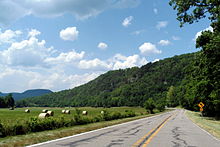Newton County, Arkansas
| Newton County, Arkansas | |
|---|---|

|
|
 Location in the U.S. state of Arkansas |
|
 Arkansas's location in the U.S. |
|
| Founded | December 14, 1842 |
| Named for | Thomas Willoughby Newton |
| Seat | Jasper |
| Largest city | Jasper |
| Area | |
| • Total | 823 sq mi (2,132 km2) |
| • Land | 821 sq mi (2,126 km2) |
| • Water | 2.3 sq mi (6 km2), 0.3% |
| Population (est.) | |
| • (2015) | 7,913 |
| • Density | 10/sq mi (4/km²) |
| Congressional districts | 3rd, 4th |
| Time zone | Central: UTC-6/-5 |
Newton County is a county located in the U.S. state of Arkansas. As of the 2010 census, the population was 8,330. The county seat is Jasper. Newton County is Arkansas's 46th county, formed on December 14, 1842, and named for Thomas W. Newton, an Arkansas Congressman. It is an alcohol prohibition or dry county.
Newton County is part of the Harrison , AR Micropolitan Statistical Area.
Newton County residents were very divided during the Civil War, serving in both the Confederate and Union armies. John Cecil, who had earlier served as Newton County's sheriff, served as a Confederate Captain. Jasper blacksmith James R. Vanderpool (ca. 1832-1880) served as Captain of Union Company C, 1st Regiment Arkansas Infantry Volunteers, while farmer and teacher John McCoy (1820–1903) served as Captain of Union Company F, 1st Regiment Arkansas Infantry Volunteers. Many Newton County citizens served under each of these men, as well as in other units. As an example of how the war divided families, Confederate Captain Cecil's brother, Sam, served as a sergeant in Union Company D, 2nd Regiment Arkansas Cavalry Volunteers. Violence took a severe toll on the civilian population, and at one point, Captains McCoy and Vanderpool escorted 20 wagons of Unionist families from Newton County to Missouri to seek refuge.
According to the U.S. Census Bureau, the county has a total area of 823 square miles (2,130 km2), of which 821 square miles (2,130 km2) is land and 2.3 square miles (6.0 km2) (0.3%) is water.
...
Wikipedia
